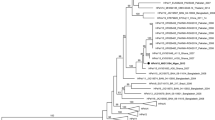Abstract
The amino acid sequences of the NP, P, M, F, HN and L proteins of the paramyxovirus Tianjin strain were analyzed by using the bioinformatics methods. Phylogenetic analysis based on 6 structural proteins among the Tianjin strain and 25 paramyxoviruses showed that the Tianjin strain belonged to the genus Respirovirus, in the subfamily Paramyxovirinae, and was most closely related to Sendai virus (SeV). Phylogenetic analysis with 14 known SeVs showed that Tianjin strain represented a new evolutionary lineage. Similarities comparisons indicated that Tianjin strain P protein was poorly conserved, sharing only 78.7%–91.9% amino acid identity with the known SeVs, while the L protein was the most conserved, having 96.0%–98.0% amino acid identity with the known SeVs. Alignments of amino acid sequences of 6 structural proteins clearly showed that Tianjin strain possessed many unique amino acid substitutions in their protein sequences, 15 in NP, 29 in P, 6 in M, 13 in F, 18 in HN, and 29 in L. These results revealed that Tianjin strain was most likely a new genotype of SeV. The presence of unique amino acid substitutions suggests that Tianjin strain maybe has a significant difference in biological, pathological, immunological, or epidemiological characteristics from the known SeVs.
Similar content being viewed by others
References
Horikami S M, Smallwood S, Moyer S A. 1996. The Sendai virus V protein interacts with the NP protein to regulate viral genome RNA replication. Virology, 222(2):383–390.
Hosaka M, Nagahama M, Kim W S, et al. 1991. Arg-X-Lys/Arg-Arg motif as a signal for precursor cleavage catalyzed by furin within the constitutive secretory pathway. J Biol Chem, 266(19): 12127–12130.
Jorgensen E, Collins P L, Lomedico P T, et al. 1987. Cloning and nucleotide sequence of Newcastle disease virus hemagglutinin-neuraminidase mRNA: identification of a putative sialic acid binding site. Virology, 156(1): 12–24.
Li M, Shi J D, Shi L Y, et al. 2007. Phylogenetic analysis of a novel paramyxovirus causing Common Cotton-eared Marmosets severe lower respiratory tract infection. Chin J Microbiol Immunol, 27(7): 603–606.
Li M, Shi L Y, Yuan L J, et al. 2008. Complete genome sequence analysis of a newly isolated paramyxovirus Tianjin Strain. Chin J Virol, 24(1): 1–6.
Meyers T, Pieters A, Moyer S A. 1997. A highly conserved region of the Sendai virus nucleocapsid protein contributes to the NP-NP binding domain. Virology, 229(2): 322–335.
Nagai Y. 1999. Paramyxovirus replication and patho-genesis. Reverse genetics transforms understanding. Rev Med Virol, 9(2): 83–99.
Sakaguchi T, Kiyotani K, Sakaki M, et al. 1994. A field isolate of Sendai virus: its high virulence to mice and genetic divergence form prototype strains. Arch Virol, 135 (1–2): 159–164.
Sakaguchi T, Uchiyama T, Huang C, et al. 2002. Alteration of Sendai virus morphogenesis and nucleocapsid incorporation due to mutation of cysteine residues of the matrix protein. Virology, 76(4): 1682–1690.
Shi J D, Li X M, Liu F Y, et al. 2003. Isolation and identification of a lethal viral pathogen from commoneared marmosets. Virologica Sinica, 18(4): 357–361.
Shi L Y, Li X M, Li M, et al. 2007. Molecular cloning and sequence analysis of fusion gene of paramyxovirus Tianjin strain. Chin J Microbiol Immunol, 27(8): 583–589.
Tashiro M, Yokogoshi Y, Tobita K, et al. 1992. Tryptase Clara, an activating protease for Sendai virus in rat lungs, is involved in pneumopathogenicity. J Virol, 66(12):7211–7216.
Tuckis J, Smallwood S, Feller J A, et al. 2002. The C-terminal 88 amino acids of the Sendai virus P protein have multiple functions separable by mutation. Virology, 76(1): 68–77.
Wang X L, Itoh M, Hotta H, et al. 1994. A protease activation mutant, MVCES1, as a safe and potent live vaccine derived from currently prevailing Sendai virus. J Virol, 68(5): 3369–3373.
Yang Y, Ren L F, Zhang H, et al. 2006. The complete cDNA sequence of Sendai virus isolate BB1 and comparison with the other isolates. Chin J Virol, 22(2):96–100.
Author information
Authors and Affiliations
Corresponding author
Additional information
Foundation item: National natural science foundation of China (30471530)
Rights and permissions
About this article
Cite this article
Shi, Ly., Li, M., Li, Xm. et al. Bioinformatic analysis of structural proteins of paramyxovirus Tianjin strain. Virol. Sin. 23, 279–286 (2008). https://doi.org/10.1007/s12250-008-2947-6
Received:
Accepted:
Published:
Issue Date:
DOI: https://doi.org/10.1007/s12250-008-2947-6




